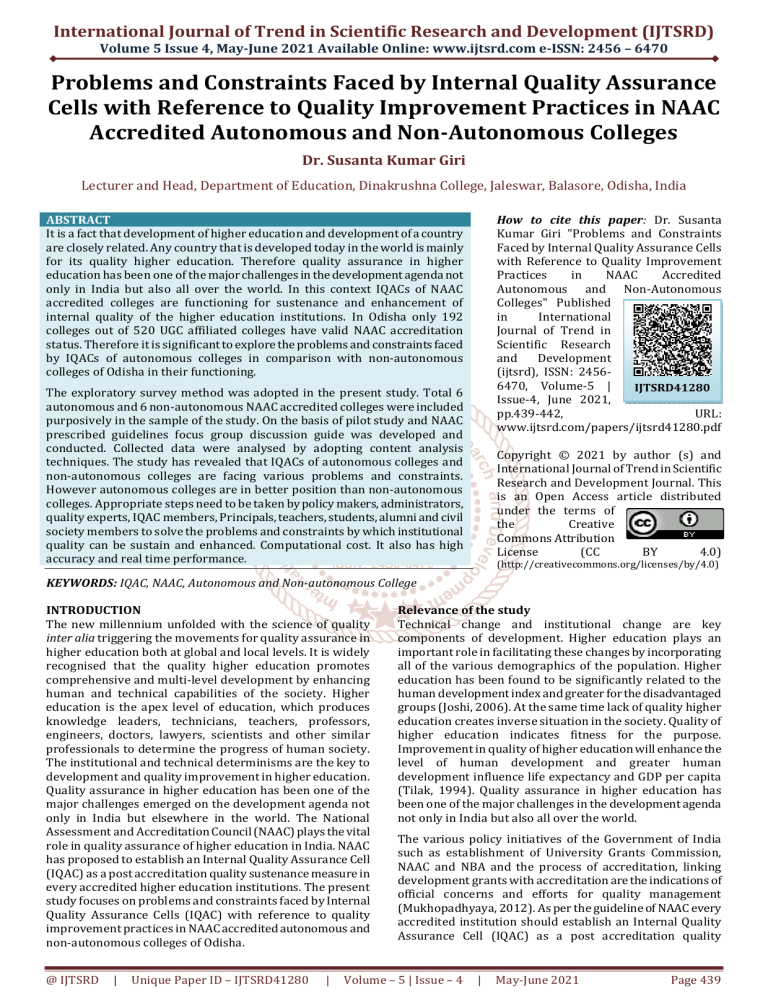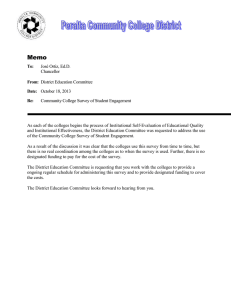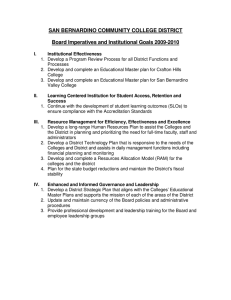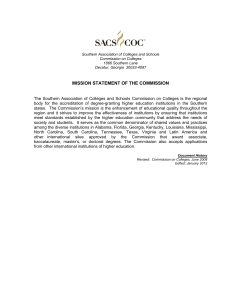
International Journal of Trend in Scientific Research and Development (IJTSRD)
Volume 5 Issue 4, May-June 2021 Available Online: www.ijtsrd.com e-ISSN: 2456 – 6470
Problems and Constraints Faced by Internal Quality Assurance
Cells with Reference to Quality Improvement Practices in NAAC
Accredited Autonomous and Non-Autonomous Colleges
Dr. Susanta Kumar Giri
Lecturer and Head, Department of Education, Dinakrushna College, Jaleswar, Balasore, Odisha, India
How to cite this paper: Dr. Susanta
Kumar Giri "Problems and Constraints
Faced by Internal Quality Assurance Cells
with Reference to Quality Improvement
Practices
in
NAAC
Accredited
Autonomous and Non-Autonomous
Colleges" Published
in
International
Journal of Trend in
Scientific Research
and
Development
(ijtsrd), ISSN: 24566470, Volume-5 |
IJTSRD41280
Issue-4, June 2021,
pp.439-442,
URL:
www.ijtsrd.com/papers/ijtsrd41280.pdf
ABSTRACT
It is a fact that development of higher education and development of a country
are closely related. Any country that is developed today in the world is mainly
for its quality higher education. Therefore quality assurance in higher
education has been one of the major challenges in the development agenda not
only in India but also all over the world. In this context IQACs of NAAC
accredited colleges are functioning for sustenance and enhancement of
internal quality of the higher education institutions. In Odisha only 192
colleges out of 520 UGC affiliated colleges have valid NAAC accreditation
status. Therefore it is significant to explore the problems and constraints faced
by IQACs of autonomous colleges in comparison with non-autonomous
colleges of Odisha in their functioning.
The exploratory survey method was adopted in the present study. Total 6
autonomous and 6 non-autonomous NAAC accredited colleges were included
purposively in the sample of the study. On the basis of pilot study and NAAC
prescribed guidelines focus group discussion guide was developed and
conducted. Collected data were analysed by adopting content analysis
techniques. The study has revealed that IQACs of autonomous colleges and
non-autonomous colleges are facing various problems and constraints.
However autonomous colleges are in better position than non-autonomous
colleges. Appropriate steps need to be taken by policy makers, administrators,
quality experts, IQAC members, Principals, teachers, students, alumni and civil
society members to solve the problems and constraints by which institutional
quality can be sustain and enhanced. Computational cost. It also has high
accuracy and real time performance.
Copyright © 2021 by author (s) and
International Journal of Trend in Scientific
Research and Development Journal. This
is an Open Access article distributed
under the terms of
the
Creative
Commons Attribution
License
(CC
BY
4.0)
(http://creativecommons.org/licenses/by/4.0)
KEYWORDS: IQAC, NAAC, Autonomous and Non-autonomous College
INTRODUCTION
The new millennium unfolded with the science of quality
inter alia triggering the movements for quality assurance in
higher education both at global and local levels. It is widely
recognised that the quality higher education promotes
comprehensive and multi-level development by enhancing
human and technical capabilities of the society. Higher
education is the apex level of education, which produces
knowledge leaders, technicians, teachers, professors,
engineers, doctors, lawyers, scientists and other similar
professionals to determine the progress of human society.
The institutional and technical determinisms are the key to
development and quality improvement in higher education.
Quality assurance in higher education has been one of the
major challenges emerged on the development agenda not
only in India but elsewhere in the world. The National
Assessment and Accreditation Council (NAAC) plays the vital
role in quality assurance of higher education in India. NAAC
has proposed to establish an Internal Quality Assurance Cell
(IQAC) as a post accreditation quality sustenance measure in
every accredited higher education institutions. The present
study focuses on problems and constraints faced by Internal
Quality Assurance Cells (IQAC) with reference to quality
improvement practices in NAAC accredited autonomous and
non-autonomous colleges of Odisha.
@ IJTSRD
|
Unique Paper ID – IJTSRD41280
|
Relevance of the study
Technical change and institutional change are key
components of development. Higher education plays an
important role in facilitating these changes by incorporating
all of the various demographics of the population. Higher
education has been found to be significantly related to the
human development index and greater for the disadvantaged
groups (Joshi, 2006). At the same time lack of quality higher
education creates inverse situation in the society. Quality of
higher education indicates fitness for the purpose.
Improvement in quality of higher education will enhance the
level of human development and greater human
development influence life expectancy and GDP per capita
(Tilak, 1994). Quality assurance in higher education has
been one of the major challenges in the development agenda
not only in India but also all over the world.
The various policy initiatives of the Government of India
such as establishment of University Grants Commission,
NAAC and NBA and the process of accreditation, linking
development grants with accreditation are the indications of
official concerns and efforts for quality management
(Mukhopadhyaya, 2012). As per the guideline of NAAC every
accredited institution should establish an Internal Quality
Assurance Cell (IQAC) as a post accreditation quality
Volume – 5 | Issue – 4
|
May-June 2021
Page 439
International Journal of Trend in Scientific Research and Development (IJTSRD) @ www.ijtsrd.com eISSN: 2456-6470
sustenance measure. Since quality enhancement is a
continuous process, the IQAC would become a part of the
institution’s system and work towards realisation of the
goals of quality enhancement and sustenance. Efforts are
being made on the part of NAAC accredited colleges to
promote internal quality enhancement practices in
respective institutions (Sahoo and Srivastva, 2015). The
National Knowledge Commission Report (2006) and the
Yashpal Committee Report (2009) on renovation and
rejuvenation for structural reforms of higher education are
of noteworthy to visualize the futures expansion of higher
education in India. We must foster a conception of quality
which may be applied to every degree of ability and to every
socially acceptable activity. A missile may blow up on its
launching pad because the designer was incompetent or
because the mechanic who adjusted the last valve was
incompetent. The same is true of everything else in our
society. It is in this context of fast changing global
development in the domain of higher education the learners’
need to have updated knowledge resources and adequate
knowledge for their utilization (Das, 2012).
The 12th five year plan suggests a range of reforms in higher
education to change the role of the Central Government from
“command and control” to “steer and evaluate” giving more
autonomy and accountability to the state and to the higher
education institutions themselves with the goal of improving
quality. In the context of Odisha immediate attention on the
part of regional government is required not mere as the
concurrent responsibility but as an unaltered major player of
regulating and development of higher education institutions
(Dansana, 2013). So, according to demands and needs there
has been substantial development in higher education in
different regions of India. To respond to the present
situation the State of Odisha has taken many initiatives in the
recent times. It has well organized system of higher
education supported by internal and external agencies.
There are 520 degree colleges in Odisha, out of which 472
colleges come under section 2 (f) and 12 (B) of the UGC Act,
1956 and 48 colleges come under section 2 (f) only but are
not included under section 12 (B) of the UGC Act, 1956,
(UGC, 2018 A). Out of these total degree colleges 44 are
autonomous colleges (UGC, 2018B). Up to 27th November
2017 there were 14 university and 192 colleges in Odisha
having valid NAAC accreditation status. (NAAC, 2017A and B).
Internal Quality Assurance Cell is UGC sponsored scheme to
be established in all its affiliated colleges with the financial
support to plan, guide and monitor quality enhancement and
assurance activities at institutional level. IQACs are
functioning to attain excellence in NAAC accredited colleges
in the state of Odisha. Especially it is significant to know how
autonomous status of the colleges have made special use of
this scheme in comparison to non-autonomous colleges. This
paper is based on research conducted in 12 NAAC accredited
colleges in Coastal Odisha. Here an attempt has been made to
present problems and constraints faced by IQACs of
Autonomous and Non-autonomous colleges in quality
improvement practices.
Objectives
The objectives of the present study is to explore the
problems and constraints faced by IQACs in their
functioning.
@ IJTSRD
|
Unique Paper ID – IJTSRD41280
|
Methods and Procedures
All NAAC accredited colleges of Odisha having IQACs were
considered as the population of the study. Out of 12 NAAC
accredited colleges of Coastal Odisha 6 autonomous and 6
non-autonomous colleges were included purposively in the
sample of the study. The sample respondents covered 72
members i. e. six from each sample institution. A pilot study
was conducted in two autonomous and two nonautonomous colleges to identify the areas where IQACs are
functioning. On the basis of pilot study and NAAC prescribed
guidelines focus group discussion guide was developed.
Focus group discussions were conducted at institutional
level as well as cluster level and collected data was analysed
by content analysis techniques.
Analysis and Interpretation
The major findings related to problems and constraints faced
by IQACs in their functioning has been presented on the
basis of two contexts as follows:
Context I: Problems and Constraints faced by IQACs in
Autonomous Colleges
The major findings related to problems and constraints faced
by IQACs in autonomous-urban-government colleges have
been presented as follows:
1.
The curriculum of autonomous-urban-government
colleges were revised occasionally due to lack of proper
planning, lack of human resources and apathetic attitude
of the college authority. These colleges have faced
problems in effective implementation of newly
introduced CBCS curriculum. The vital constraints of the
above problem was lack of proper orientation to
faculties and large scale vacancy in teaching posts. No
regular feedbacks were taken from stakeholders for
curriculum updating and revision, as no continuous
efforts were taken by authority.
2.
Autonomous-Urban-Government
colleges
faced
problems in enrolling students as per students’ first
choice due to cut off marks in e-admission system. These
colleges faced problems in maintaining students profile
at department level. Due to lack of office automation/
computerisation it was not easy to share students
profile to all departments. It was found in the colleges
that less importance were given on workshop, group
discussions, poster making, field study and seminar
presentation due to more importance on traditional
practice of lecture method. The colleges have ICT
enabled resources but it was used occasionally due to
lack of well-trained regular faculties.
3.
Major problems faced by IQACs of autonomous-urbangovernment colleges in research, consultancy and
extension activities were lack of promotion of research,
inactive college research committee, lack of publication
output, no consultancy and no collaboration with other
organisations. These problems were aroused due to
several important constraints such as lack of motivation
of the faculties and administrators, lack of inspiration by
administration, no special incentives/facilities by college
administration, no official policy for structured
consultancy, lack of structured planning and lack of
interest among the faculties as well as administrators.
4.
The major problems faced by autonomous-urbangovernment colleges in infrastructure and learning
resources were lack of canteen facilities, lack of study
Volume – 5 | Issue – 4
|
May-June 2021
Page 440
International Journal of Trend in Scientific Research and Development (IJTSRD) @ www.ijtsrd.com eISSN: 2456-6470
room for teachers, lack of ICT as learning resources, lack
of library automation and lack of sufficient hostel
facilities. These problems were aroused due to several
important constraints such as lack of interest of the
principals, lack of infrastructure, lack of training to the
faculties about the uses of ICT, lack of incentive as well
as motivation, lack of funds, lack of trained librarian and
lack of proper planning.
5.
Students of autonomous-urban-government colleges
were less aware about the availability of variety of
scholarship. The colleges have not maintaining records
about students’ progress to next higher studies and
getting employed. The important constraints were lack
of proper guidance in career advancement. Less
participation in co-curricular activities by students were
also an important problem of these colleges and the
related constraints were lack of awareness and interest
among the students. Autonomous colleges have
placement and career counselling cells, but they were
not working properly. Apathetic attitude of the authority
as well as lack of manpower was the important
constraints of it.
6.
The major problems faced by IQACs of autonomousurban-government colleges in governance, leadership
and management were less involvement of stakeholders,
lack of execution of vision document, formation of
governing body of the college and Irregular submission
of AQAR. These problems were aroused due to several
important constraints such as no continuous planning,
no continuous effort, local political interference,
apathetic attitude/negligence.
7.
The problems and constraints with reference to
innovations and best practices of accredited
autonomous-urban-government colleges during the
implementation of follow up activities on peer team
recommendations were lack of regular functioning of
IQACs, lack of stakeholders’ relationship and inadequate
study environment of the campus. These problems were
aroused due to several important constraints such as
lack of interest among the members of IQACs, no
assignment to a particular staff to look after the matter
and lack of awareness as well as co-operation among the
members and coordinators of IQACs.
Context II: Problems and Constraints faced by IQACs in
Non-autonomous Colleges
The major findings related to problems and constraints faced
by IQACs in non-autonomous-rural-non-government-aided
colleges have been presented as follows:
1.
The curriculum of non-autonomous-rural-nongovernment-aided colleges were revised occasionally by
the affiliating University. In this matter the above
colleges have limited opportunity due to lack of
autonomy. Only some senior faculties, who were
members of ‘Board of Studies’ have limited opportunity
to participate in curriculum revision process. Nonautonomous colleges have faced problems in effective
implementation of newly introduced CBCS curriculum.
The vital constraints of the above problem was lack of
proper orientation to faculties and large scale vacancy in
teaching posts. The above colleges have limited
academic flexibility due to lack of diversified courses.
The above colleges faced problems in curriculum
enrichment due to lack of sufficient quality materials. No
@ IJTSRD
|
Unique Paper ID – IJTSRD41280
|
regular feedbacks were taken from stakeholders for
curriculum updating and revision, as no continuous
efforts were taken by authority.
2.
Non-autonomous-Rural-Non-government-aided colleges
faced problems in enrolling students as per students’
first choice due to cut off marks in e-admission system.
Above colleges faced problems in maintaining students
profile at department level, only college offices have
been maintained students’ profile. Due to lack of office
automation/ computerisation it was not easy to share
students profile to all departments. It was found that
less importance were given on workshop, group
discussions, poster making, field study and seminar
presentation due to more importance on traditional
practice of lecture method. The above colleges have lack
of ICT enabled resources as well as lack of trained
faculty to use ICT enabled devices. The major
constraints in teaching-learning & evaluation were lack
of well-trained faculty, lack of resources and lack of
regular teaching faculties.
3.
Major problems faced by IQACs of non-autonomousrural-non-government-aided colleges in research,
consultancy and extension activities were lack of
promotion of research, inactive college research
committee, lack of publication output, no consultancy
and no collaboration with other organisations. The
above problems were aroused due to several important
constraints such as lack of motivation of the faculties
and administrators, no weightage on research for
promotion, lack of inspiration by administration, no
incentives/ facilities by college administration, no
official policy for structured consultancy, lack of
structured planning and lack of interest among the
faculties as well as administrators.
4.
The major problems faced by non-autonomous-ruralnon-government-aided colleges in infrastructure and
learning resources were lack of canteen facilities, lack of
study room for teachers, lack of ICT as learning
resources, lack of library automation and lack of
sufficient hostel facilities. The above problems were
aroused due to several important constraints such as
lack of interest of the principals, lack of infrastructure,
lack of training to the faculties about the uses of ICT,
lack of incentive as well as motivation, lack of funds, lack
of trained librarian and lack of proper planning.
5.
There were less participation of students in various
societies in non-autonomous-rural-non-governmentaided colleges due to lack of interest and awareness
among students. In these colleges students were
deprived of getting the opportunity of scholarship due to
lack of awareness among them. Another problem of
these colleges were students’ progression from UG to PG
or next higher studies. The important constraints of the
above problem was lack of proper guidance in career
advancement. Less participation in co-curricular
activities by students were also an important problem of
these colleges and the related constraints were lack of
awareness and interest among the students. Nonautonomous-rural-non-government-aided colleges have
no placement and career counselling cells. Apathetic
attitude as well as lack of human resource were the
important constraints of it.
Volume – 5 | Issue – 4
|
May-June 2021
Page 441
International Journal of Trend in Scientific Research and Development (IJTSRD) @ www.ijtsrd.com eISSN: 2456-6470
6.
The major problems faced by IQACs of non-autonomousrural-non-government-aided colleges in governance,
leadership and management were less participation of
stakeholders, lack of execution of vision document,
formation of governing body of the college and Irregular
submission of AQAR. The above problems were aroused
due to several important constraints such as no
continuous planning, no continuous effort, local political
interference, apathetic attitude and negligence of the coordinator of IQACs.
7.
The problems and constraints with reference to
innovations and best practices of accredited nonautonomous-rural-non-government-aided
colleges
during the implementation of follow up activities on
peer team recommendations were lack of regular
functioning of IQACs, lack of stakeholders’ relationship
and Poor environment of the campus. The above
problems were aroused due to several important
constraints such as lack of interest among the members
of IQACs, no assignment to a particular staff to look after
the matter and lack of awareness as well as co-operation
among the members and coordinators of IQACs.
Conclusions
Irrespective of contexts of colleges, problems and
constraints are found across seven quality dimensions of
NAAC. Major problems are Irregular updating of curriculum,
less use of ICT enabled devices, less importance on group
discussion, poster making, seminar etc., inactive college
research committee, apathetic attitude of the stakeholders,
lack of publication output, incomplete library automation
process, lack of hostel facilities, less participation of students
in co-curricular activities, limited academic audit, no vision
documents, irregular submission of AQAR, lack of interest
among IQAC members. The major constraints of the above
mentioned problems are lack of structured planning,
inequality in salary, service insecurity, improper policy for
professional growth, lack of infrastructure, lack of funds, lack
of proper orientation, large scale vacancy, apathetic attitude
of college authority, more importance on traditional
methods of teaching, lack of motivation, no special
incentives, lack of trained librarian, negligence attitude and
inconsistent tenure of IQAC coordinators.
Recommendations
The present study have many seminal implications for policy
makers, administrators, quality experts, IQAC members,
Principals, teachers, students, alumni and civil society
members. More or less the IQACs of autonomous colleges
and non-autonomous colleges are facing problems and
constraints. They require to give importance on regular
updating of curriculum, use of ICT enabled teaching learning
devices, orienting faculty members with updated knowledge
and skills, organise doubt clearing/tutorial classes for slow
learners, create achievement motive among the students,
enhance computerisation of institutional administration,
examination and accounts related activities, involve
stakeholders in quality improvement process, motivate
faculty members to undertake major and minor research
projects. The IQACs must be more particular about
documentation of quality related activities and disseminate
the same by uploading it in their institutional websites. The
authority of the institutions seek the assistance of alumni
and government authority for internal quality improvement
@ IJTSRD
|
Unique Paper ID – IJTSRD41280
|
process of the institutions. Necessary step needs to be
undertaken by appropriate authority to fill up the vacancies
of both teaching and non-teaching posts on regular basis
without any compromise, because productive functioning of
any institution highly depends upon its human resources. In
the rapidly changing scenario of needs and demands, every
college needs to explore the possibility of introducing more
need-based diversified courses supplemented with job
oriented professional subjects and quality infrastructure.
References
[1] Dansana, A. (2013). Higher Education and Sustainable
Development: New Challenges and Opportunities. New
Delhi, Regal Publications.
[2]
Das, B.C. (2012). Participative Learning, In P.K. Sahoo,
D. Yadav & B.C. Das (Eds), Quality in Higher Education:
Issues and Practices. (pp.376-388), New Delhi, Uppal
Publishing House.
[3]
Government of India, (1986). Programme of Action,
National Policy on Education, 1986, MHRD, GOI, New
Delhi.
[4]
Joshi, K.M. (2006). Human Capital and the Economic
Benefits of Education: Understanding the Investment
Arguments, Working Paper No. 1/06, OSED.
[5]
Mukhopadhyaya, M. (2012). Quality Management in
Higher Education, In P.K. Sahoo, D. Yadav & B.C. Das
(Eds), Quality in Higher Education: Issues and
Practices. (pp.16-33), New Delhi, Uppal Publishing
House.
[6]
NAAC, 2017 (A). Institutions accredited by NAAC
whose accreditation period is valid (Institutions
assessed prior to 01st July 2016)
[7]
NAAC, 2017 (B). National Assessment and
Accreditation Council, Bengaluru Institutions
assessed under new grading system of NAAC
(Institutions assessed after 01st July 2016)
[8]
National Knowledge Commission (2007) Report to the
Nation 2006. New Delhi: Government of India.
Organised by NAAC Bangalore during 2-4th March
2011.
[9]
Sahoo, P.K and Srivastva, M. (2015). Functioning of
Internal Quality Assurance Cells in Autonomous and
General Colleges. University News, 53 (07), February
16-22, 2015.
[10]
Tilak, J.B.G. (1994). Education for Development in Asia.
New Delhi, Sage Publications.
[11]
UGC (2018). Status List of Approved Autonomous
Colleges,
https://www.ugc.ac.in/oldpdf/colleges/autonomous_
colleges-list.pdf
[12]
UGC (2018). Status List of 2 (f) and 12 (B) affiliated
colleges,
https://www.ugc.ac.in/oldpdf/colleges/List%20of%
20colleges%20as%20on%2031.05.2018.pdf
[13]
UGC. (2012-17). 12 Plan Guideline for Establishment
and Monitoring of the Internal Quality Assurance Cell
(IQAC) in Higher Education Institutions.
Volume – 5 | Issue – 4
|
May-June 2021
Page 442






